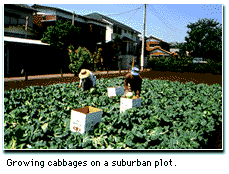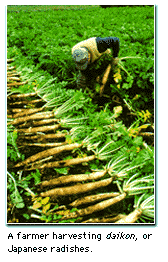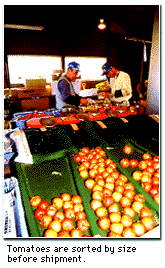 |
Besides rice, what else is grown in Japan? |
 |
 Japan's most important agricultural product is rice--the country's staple food. But Japanese farmers also grow a wide assortment of other products, such as barley, beans, vegetables, and fruits.
Japan's most important agricultural product is rice--the country's staple food. But Japanese farmers also grow a wide assortment of other products, such as barley, beans, vegetables, and fruits.Production of items other than rice is on a small scale, however, because of the shortage of farmers--only 5% of the working population was engaged in agriculture in 1996--due to the mountainous nature of the land, the lack of arable land (one-fortieth the area of U.S. farmland), and high production costs.
In 1996 Japan was 100% self-sufficient in rice; the figure was 86% for vegetables, 47% for fruit, 7% for barley, and just 5% for beans. The country is thus heavily dependent on imports to make up for shortages in domestic production. In 1996, agricultural products accounted for 14.5% of the total value of imports.
|
| Production | Imports | Consumption | Self-sufficiency ratio (%) | |
| Vegetables | 14,600 | 2,628 | 17,228 | 85 |
| Rice | 10,748 | 495 | 10,485 | 103 |
| Dairy products | 8,469 | 3,293 | 11,809 | 72 |
| Fish, shellfish | 6,722 | 6,755 | 11,935 | 74 |
| Fruit | 4,232 | 4,524 | 8,638 | 49 |
| Potatoes, sweet potatoes | 4,546 | 683 | 5,228 | 87 |
| Meat | 3,160 | 2,413 | 5,579 | 57 |
| Eggs | 2,550 | 110 | 2,660 | 96 |
| Wheat | 444 | 5,750 | 6,355 | 7 |
| Legumes | 284 | 5,126 | 5,373 | 5 |
| Corn | 0 | 15,983 | 15,972 | 0 |
Source: Ministry of Agriculture, Forestry, and Fisheries, Shokuryo jukyu hyo (Food Supply and Demand Tables).
 |


